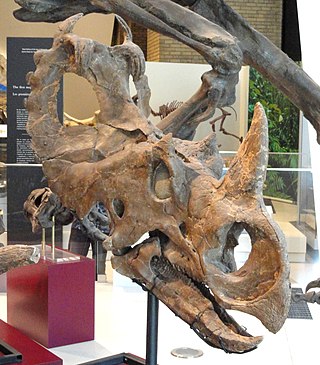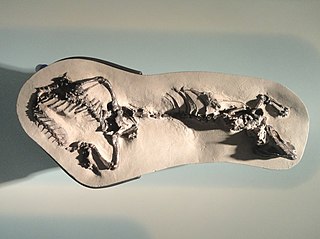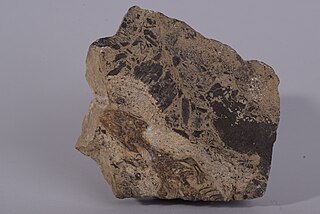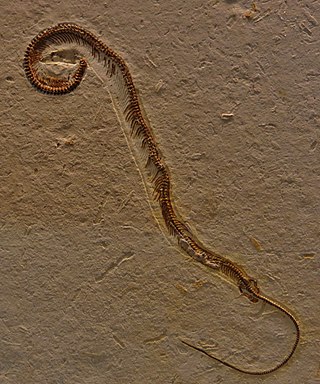
A bone bed is any geological stratum or deposit that contains bones of whatever kind. Inevitably, such deposits are sedimentary in nature. Not a formal term, it tends to be used more to describe especially dense collections such as Lagerstätte. It is also applied to brecciated and stalagmitic deposits on the floor of caves, which frequently contain osseous remains.

Pachyrhinosaurus is an extinct genus of centrosaurine ceratopsid dinosaur from the late Campanian and middle Maastrichtian ages of the Late Cretaceous period of northwest North America. The first examples were discovered by Charles M. Sternberg in Alberta in 1946 and named in 1950. Over a dozen partial skulls and a large assortment of other fossils from various species have been found throughout Alberta and Alaska. A great number were not available for study until the 1980s, which resulted in a relatively recent increase of interest in Pachyrhinosaurus.

Centrosaurus is a genus of herbivorous ceratopsian dinosaur from the Late Cretaceous of Canada. Their remains have been found in the Dinosaur Park Formation, dating from 76.5 to 75.5 million years ago.
Polyodontosaurus is a potentially dubious genus of troodontid dinosaur named in 1932 by Charles W. Gilmore for a left dentary from the Dinosaur Park Formation. It had been considered a synonym of Stenonychosaurus or Troodon for a significant time, before being declared a nomen dubium. The only known species is the type, P. grandis.

The Judith River Formation is a fossil-bearing geologic formation in Montana, and is part of the Judith River Group. It dates to the Late Cretaceous, between 79 and 75.3 million years ago, corresponding to the "Judithian" land vertebrate age. It was laid down during the same time period as portions of the Two Medicine Formation of Montana and the Oldman Formation of Alberta. It is an historically important formation, explored by early American paleontologists such as Edward Drinker Cope, who named several dinosaurs from scrappy remains found here on his 1876 expedition. Modern work has found nearly complete skeletons of the hadrosaurid Brachylophosaurus.

Albertaceratops was a genus of centrosaurine horned dinosaur from the middle Campanian-age Upper Cretaceous Oldman Formation of Alberta, Canada.

Centrosaurinae is a subfamily of ceratopsid dinosaurs, a group of large quadrupedal ornithischians. Centrosaurine fossil remains are known primarily from the northern region of Laramidia but isolated taxa have been found in China and Utah as well.

The Bearpaw Formation, also called the Bearpaw Shale, is a geologic formation of Late Cretaceous (Campanian) age. It outcrops in the U.S. state of Montana, as well as the Canadian provinces of Alberta and Saskatchewan, and was named for the Bear Paw Mountains in Montana. It includes a wide range of marine fossils, as well as the remains of a few dinosaurs. It is known for its fossil ammonites, some of which are mined in Alberta to produce the organic gemstone ammolite.
The Wapiti Formation is a geological formation of the Western Canada Sedimentary Basin in northwestern Alberta, and northeastern British Columbia, Canada. Its deposition spanned the time interval from the lower Campanian through to the upper Maastrichtian, between approximately 80 and 68 Ma. It was named by G.M. Dawson in 1881, presumably for exposures along the lower part of the Wapiti River and downstream along the Smoky River in Alberta.

Spinops is an extinct genus of centrosaurine ceratopsian dinosaur from the Late Cretaceous of Alberta, southern Canada. It was a medium-sized ceratopsian, reaching 4.5 metres (15 ft) in length and 1.3 metric tons in body mass.

Xenoceratops is a genus of centrosaurine ceratopsid dinosaur known from the Late Cretaceous, and is known to have lived in what is currently Alberta, Canada. The genus has one known species, Xenoceratops foremostensis. Its remains were discovered in the Foremost Formation.

Coronosaurus is a genus of centrosaurine ceratopsian dinosaurs which lived in the Late Cretaceous, in the middle Campanian stage. Its remains, two bone beds, were discovered by Phillip J. Currie in the Oldman Formation of Alberta, Canada, and its type and only species, Coronosaurus brinkmani, was first described in 2005, as a new species within the genus Centrosaurus. Later studies questioned the presence of a direct relationship, and in 2012 it was named as a separate genus. Coronosaurus means "crowned lizard", coming from "corona", Latin for crown, and "sauros", Greek for lizard; this name refers to the unique, crown-like shape of the horns on the top of its frill.

Polyglyphanodontia, also known as the Borioteiioidea, is an extinct clade of lizards from the Cretaceous that includes around a dozen genera. Polyglyphanodontians were the dominant group of lizards in North America and Asia during the Late Cretaceous. Most polyglyphanodontians are Late Cretaceous in age, though the oldest one, Kuwajimalla kagaensis, is known from the Early Cretaceous Kuwajima Formation (Japan). Early Cretaceous South American taxon Tijubina, and possibly also Olindalacerta, might also fall within Polyglyphanodontia or be closely allied to the group, but if so, they would be two of only three Gondwanan examples of an otherwise Laurasian clade. They produced a remarkable range of forms. Chamopsiids, including Chamops, were characterized by large, blunt, crushing teeth, and were most likely omnivores. Macrocephalosaurus, from the Gobi Desert, was a specialized herbivore; it grew to roughly a meter long and had multicusped, leaf-shaped teeth like those of modern iguanas. Polyglyphanodon, from the Maastrichtian of Utah, was another herbivore, but its teeth formed a series of transverse blades, similar to those of Trilophosaurus. Peneteius had remarkable, multicusped teeth, similar to those of mammals. The polyglyphanodontids first appear in the latter part of the Early Cretaceous in North America, and became extinct during the Cretaceous-Paleogene extinction event. Polyglyphanodontians closely resembled the teiid lizards, and purported teiid lizards from the Late Cretaceous appear to be polyglyphanodontians. The only species known to have survived the Cretaceous was Chamops, which survived until the very early Ypresian.

Megachirella is an extinct genus of stem-squamate that lived about 240 million years ago during the Middle Triassic and contains only one known species, Megachirella wachtleri. It is known from a partial skeleton discovered in the Dolomites of Northern Italy and was described in 2003.

Tetrapodophis is an extinct genus of lizard from the Early Cretaceous. Tetrapodophis was previously thought to be one of the oldest members of Ophidia. However, this classification has been disputed by Caldwell et al. (2016), Paparella et al. (2018) and Caldwell et al. (2021), who identify Tetrapodophis as a dolichosaurid. This species existed in the Cretaceous Period about 120 million years ago, located in modern day Brazil. This four legged animal is around 19.5 cm (7.7 in) long.
Odaxosaurus is an extinct genus of anguid lizards that existed in western North America from the Late Cretaceous to the Paleocene. Fossils of the type species Odaxosaurus piger and the species O. priscus are widespread throughout Late Cretaceous formations in the western United States and Canada. First described in 1928 from the Lance Formation in Wyoming, O. piger has since been found in the Hell Creek Formation in Wyoming and Montana, the Frenchman and Scollard formations in Alberta, and the Aguja Formation in Texas. It was one of the few species of lizards to survive the Cretaceous–Paleogene extinction event, which is estimated to have killed off 83% of all lizard species. The second species, O. priscus, was named in 1996 from the Dinosaur Park Formation in Alberta and has since been found in the Kaiparowits Formation in southern Utah. Remains of an anguid from the Kirtland Formation in New Mexico may also belong to Odaxosaurus.
Catactegenys is an extinct genus of xantusiid lizard from the Late Cretaceous of Texas. The type species, Catactegenys solaster, was named in 2013 from the late-Campanian-age Aguja Formation in Brewster County. The genus name means "breaker jaw" in Greek, a reference to its inferred ability to break hard shells with its jaws as an adaptation for a durophagous diet, and the species name means "lone star", a reference to Texas, the "lone star state". Catactegenys is known only from jaw bones, but the size of these bones indicates that it was larger than all other known xantusiids. The teeth are robust and heavily worn, suggesting that Catactegenys may have eaten hard-shelled molluscs, which are common in the Aguja Formation.
Chamops is an extinct genus of polyglyphanodontian lizard from the Late Cretaceous-Early Eocene of North America. Fossils have been found in the Hell Creek Formation, Judith River Formation and Polecat Bench Formation of Montana, the Milk River Formation of Alberta, Canada and possibly also the Laramie Formation of Colorado. It is known from only one species, C. segnis. Chamops grew to approximately 0.5 meters long, and 2 kilograms in weight. Unlike other polyglyphanodonts, Chamops had a more blunt snout. Chamops belonged to the Chamopsiid family of polyglyphanodonian lizards that lived in the Northern Hemisphere during the Late Cretaceous, although there are some possible Chamopsiid genera from South America and the Kem Kem Bone Beds in Morocco. It was originally thought Chamops and kin are related to whiptails, although it is now thought they are more closely related to iguanas.
Saurosternon is an extinct genus of neodiapsid reptile from the Late Permian of South Africa. It is based on a partial skeleton split between two slabs of sandstone from the Daptocephalus Assemblage Zone. Saurosternon was one of the earliest small lizard-like reptiles to be discovered in Permian deposits of the Karoo Supergroup, preceding later discoveries such as Paliguana, Youngina, Palaeagama, and Lacertulus. The skeleton is mostly complete, though missing the head. Most of the original bone had decayed away by the time the fossil was discovered, leaving perfect molds in the sandstone slabs. What little bone remained was removed with acid by museum preparators, and the specimen was cast with latex to reconstruct the original bone shape.












